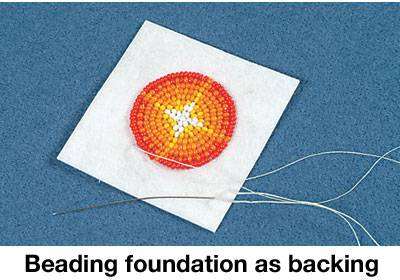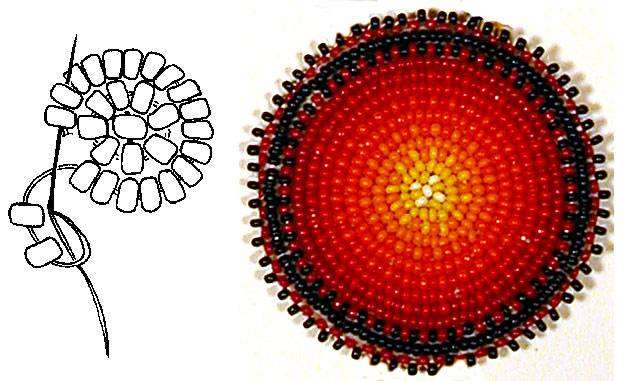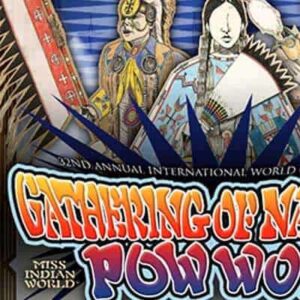This project will help you learn to do applique rosettes on a small project. Beaded medallion necklaces have been popular for both men and women dancers for many generations. These instructions suggest using the new beading foundation as the material to sew the beads onto. It is a stiffened fabric that helps you keep the rosette flat while pulling the threads tight (Figure 1)

Materials needed for a 2 inch diameter medallion:
1 – Piece of Beading Foundation 2 1/8″ x 2 1/8″
2 – 3/4″ Brass cones
1 – Soft leather thong 42″
2 – Hairpipe
12 – Crow beads
1 – Piece of leather for backing 2 1/8″ x 2 1/8″
1 – Bobbin of “B” nylon thread
1- Sharps needle, size 11
1 – Piece of bee's wax
Assortment of seed beads, usually size 11
The first step is to decide your pattern using the color beads you have. A planning graph pattern is shown here (Figure 2) which you can use if you are doing a centered circular pattern. Use color pencils and plan the pattern. For image patterns like the turtle in our photo, draw the image out on the beading foundation with a pencil.

Thread your needle with a length of nylon thread. Pull the needle to the center of the thread length and double over. Wax the thread by pulling it through the bee's wax block several times with your thumb over the thread.
With either style you will be using the applique stitch shown in Figure 3. Knot the beading thread and come up with the needle through the foundation at the starting point. Usually this is at the center of the pattern. The basic step is to thread on 4 beads, stitch through the foundation, and come back up with the needle two beads back. Then pass the needle through the last 2 beads, then string on 4 more beads. Repeat the process until you return to the start of that row.

Figure 4 shows the pattern of starting the rows in the center of the rosette. Note that you start by sewing one bead into the center position.

If you are planning an image design like our turtle pattern, usually you will start sewing the beads on the outside of the pattern and then add rows on the inside until finished. For example in the turtle pattern the outside outline row of the turtle back is done first, the turtle back is then filled in, and the head, feet, and tail are added last.

Doing this kind of beading, you often have to select the width of the bead that will fit, especially the last few beads in a row. To finish a row, as you fit the last one or two beads in position, thread the needle into the holes of the first two beads sewn in that row. Pull the thread tight and then pass the needle through the foundation to fasten that row of beads in place.
You are ready to start the next row by bringing the needle up through the foundation in the start position for the pattern. If you need more thread, knot your thread on the back of the foundation and then make up a new thread and needle set up as discussed above.

When your bead work is finished, trim the foundation to match your pattern. Cut out a circle of backing leather to match. Attach the backing leather to the back of the foundation covering all of your threads and knots. A little tacky glue can be used. Sew edge beading to fasten the two layer together.

Cut the leather thong to fit the necklace over your head. Thread the haripipe and crow beads on and sew the necklace thong to the back of the rosette as shown in Figure 7.

Finish by slipping the ends into a metal cone and crimp the top with a pliers (Figure 8).

Copyright 2003 by Loren Woerpel; Noc Bay Publishing, Inc.

How To Make a Beaded Rosette Medallion
This project will help you learn to do applique rosettes on a small project. Beaded medallion necklaces have been popular for both men and women dancers for many generations.
Materials
- Materials needed for a 2-inch diameter medallion:
- 1 – Piece of Beading Foundation 2 1/8″ x 2 1/8″
- 2 – 3/4″ Brass Cones
- 1 – Soft leather thong 42″
- 2 – Hairpipe
- 12 – Crow beads
- 1 – Piece of leather for backing 2 1/8″ x 2 1/8″
- 1 – Bobbin of “B” nylon thread
- 1- Sharps needle, size 11
- 1 – Piece of bee's wax
- Assortment of seed beads, usually size 11
Instructions
- The first step is to decide your pattern using the color beads you have. A planning graph pattern is shown here (Figure 2) which you can use if you are doing a centered circular pattern. Use color pencils and plan the pattern. For image patterns like the turtle in our photo, draw the image out on the beading foundation with a pencil.

- Thread your needle with a length of nylon thread. Pull the needle to the center of the thread length and double over. Wax the thread by pulling it through the bee's wax block several times with your thumb over the thread. With either style you will be using the applique stitch shown in Figure 3. Knot the beading thread and come up with the needle through the foundation at the starting point. Usually this is at the center of the pattern. The basic step is to thread on 4 beads, stitch through the foundation, and come back up with the needle two beads back. Then pass the needle through the last 2 beads, then string on 4 more beads. Repeat the process until you return to the start of that row.

- Figure 4 shows the pattern of starting the rows in the center of the rosette. Note that you start by sewing one bead into the center position.

- If you are planning an image design like our turtle pattern, usually you will start sewing the beads on the outside of the pattern and then add rows on the inside until finished. For example in the turtle pattern the outside outline row of the turtle back is done first, the turtle back is then filled in, and the head, feet, and tail are added last.

- Doing this kind of beading, you often have to select the width of the bead that will fit, especially the last few beads in a row. To finish a row, as you fit the last one or two beads in position, thread the needle into the holes of the first two beads sewn in that row. Pull the thread tight and then pass the needle through the foundation to fasten that row of beads in place.
- You are ready to start the next row by bringing the needle up through the foundation in the start position for the pattern. If you need more thread, knot your thread on the back of the foundation and then make up a new thread and needle set up as discussed above.

- When your bead work is finished, trim the foundation to match your pattern. Cut out a circle of backing leather to match. Attach the backing leather to the back of the foundation covering all of your threads and knots. A little tacky glue can be used. Sew edge beading to fasten the two layer together. Cut the leather thong to fit the necklace over your head. Thread the haripipe and crow beads on and sew the necklace thong to the back of the rosette as shown in Figure 7.

- Finish by slipping the ends into a metal cone and crimp the top with a pliers (Figure 8).

Notes
Copyright 2003 by Loren Woerpel; Noc Bay Publishing, Inc.
Learn to make more Native American Crafts in our Craft Tutorials.
Copyright: 2005 by Loren Woerpel, Noc Bay Publishing, Inc.

Last Updated on November 25, 2019 by Paul G





Charwp
says:Thank you for this tutorial. I look forward to trying this out.
Chris poole
says:I would really like to find a medallion pattern that does not use a backing. I would like to use seed beads and weave the beads into a round like the rosette that can be worn as a necklace. Thank you
Rosa
says:Put on six and the the ends together. Then string three and go into one next bead. Three more over every other bead. When you get back to where you started go through the middele of the three and put a bead between them so on between each three. Then the next row is the three over one again. Maybe you can see this iif you play with tham
kim
says:Hi. Thank you for this. I’m going through a really tough time right now and decided I need a hobby to channel all the emotions I’m overwhelmed with. Beading will be a great outlet. Thank you for the tutorial and all the additional help from those that commented.
Redmans wife
says:Thank You this answered a lot of my questions as well. Im a mama bear of five native babies. Last year I just winged it and beaded a big butterfly on a choker and my daughters leggings for her regalia. i did it free hand but I would like to learn how to bead with the graphing paper. But wow there is so many ways. However Im willing to learn! Aho….
summer
says:I’m new to beading and have no family around who knows how to bead(I live away from my tribe) and anything I find says to just use leather to back it. Is there a specific size? I know the thickness is measured with oz. so is there a thickness preferred like 3oz.? Thank you.:)
Yolanda
says:I use different thicknesses od leather. 3 0z buckskin or deerskin is good or elk. If you use commercial grade cow hide try to get something soft and simular to deerskin. The thicker the leather the harder to get the needle through or the needle might break When i use thick leasther I have to npull the needle tghrough with pliers (takes forever)
iyeska
says:PLEASE don’t use pliers to crimp the tin cones onto the hide thongs as shown in Figure 8. The traditional method was to use knots in the thong to hold the cones in place, which are hidden inside the cone. (Mrs Sitting Bull didn’t carry a pair of needle nosed pliers around with her, yanno….)
Anyway, I realize this is a common modern shortcut, but if you want your piece to really look much neater, more traditional, and not to mention historically accurate…… use knots. Not pilers.
Robin
says:Redhawk, that is how I was taught, I used recipe cards and made my circle to start, then covered it with a piece of leather.
Nikki
says:Robin, when you say you used recipe cards then cover it with leather, do you glue the leather to the card?
Robin
says:Yes, I used 527 or E6000 to glue it on the back, then I added a border going through the leather.
redhawk74467
says:I also make medallions on stiff cardboard. If I am doing a mediallion that will be on a bag I bead locking down each of my beads sometimes using the two needle technique and sometimes just the one needle. When finished I then add a second piece of material on the back to cover up the stitches and then bead the edges so seems are not seen.
Robin
says:Thanks so much for this tutorial, I’ve been meaning to get back into beading. We moved a couple of years ago and I finally found most of my books, papers and beads, I will need to replace my wax and string. I think mostly I’ve been to scared to start up because I couldn’t remember how, but after seeing this tute most of it came back to me. Now comes the search for a good supplier close by.
Sondra
says:There is a beading foundation called Stiff Stuff. It looks like that may be what they used for the project. I will have to attempt this sometime soon, when I have the time, materials, and patience to work on it. I have never used seed beads before, so it will be a new experience for me.
choctawboy
says:For a backing I have used a playing card or any other paper of similar thickness!!! Works great.
Joyce Mountain Lion
says:I have also cut my circles out of tissue boxes. I now save all of my empty boxes for my medallions, it is just the right weight and really holds the shape.
Victoria
says:Pellon comes in different weight. I would assume you would want a medium to heavy weight. It is not batting. Batting is a much thicker material, usually used for quilts.
Zoe
says:You can purchase Pellon at Walmart or any fabric store. Pellon is also known as interfacing or iron on batting.
pam eakins
says:please tell me what kind of beading foundation are you speaking of. thank you
Paul G
says:I believe he is using pellon.
carolina arteaga
says:It is also called fabric stabilizer, look for the thickest one it works really good!! you can buy it where fabrics for sewing are sold.
Aminah
says:Peltex is what it’s called. Pellon is soft and you would have to use a embroidery hoop, but Pelts is stiff and you can use it alone.
geraldine
says:Fantastic both my parents beaded I learned a little and done a project with an elder once to get her recognized for her wonderful art we were on a commercial all winter with the beaded art we done. she has since became ill and I miss her. thank you for this it means a lot for our people to be able to pick this lost art up.
Judy Graeber
says:Wouldn’t you want the entire background to be beaded, say for the turtle?
Henry Salazar Jr
says:Yup, I think it should be White, an yellow.
Lily
says:I think you could do it what ever way you want, maybe if its for something serious then maybe you should bead the background. Lets say its your cousins or friends birthday and you want to bead them something so then you wouldn’t have to, I think whatever looks best to you than go for it. Personally I would bead the background with more colors so it looks prettier but thats just my preference. but anyways have a nice day:)